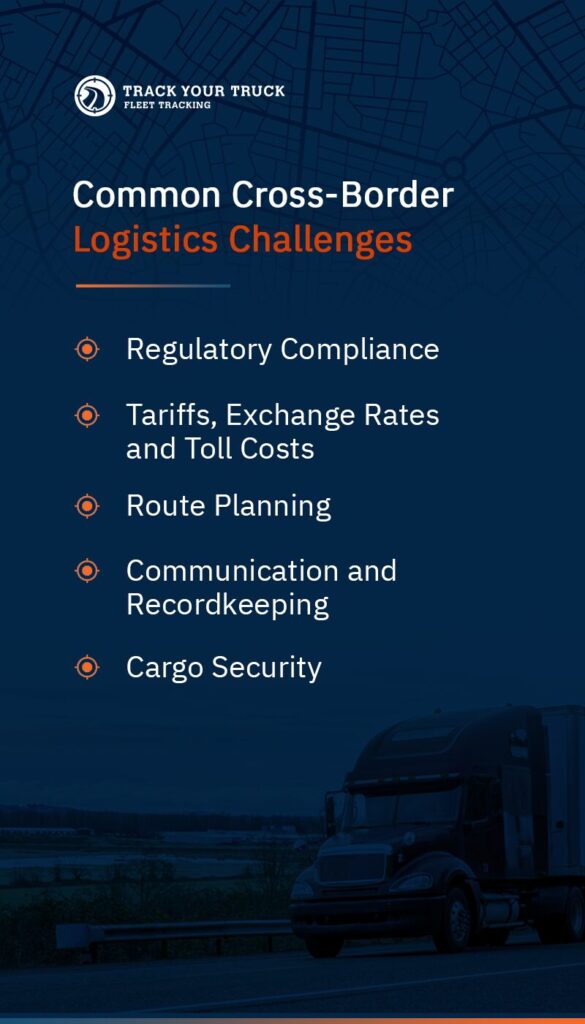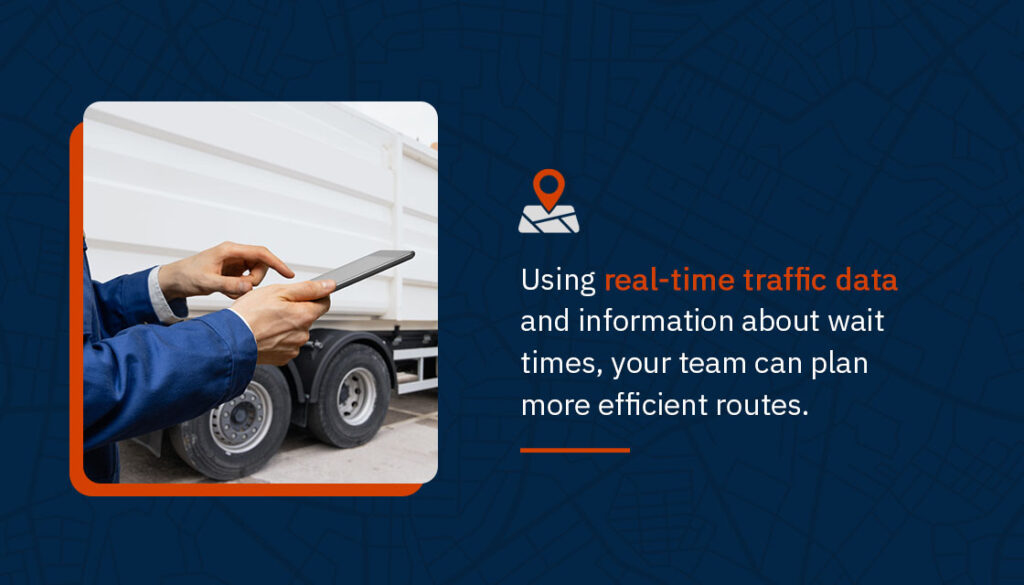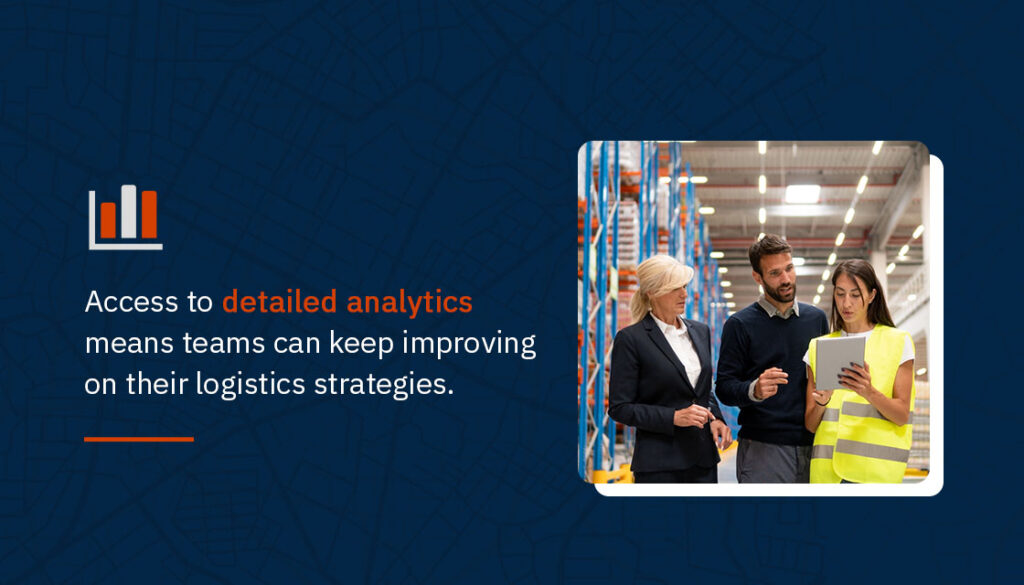
Moving goods internationally is a complex process that can benefit your company. Expanding across borders allows you to access new markets, become more competitive, mitigate supply chain risks, and experience a host of other advantages.
No matter your international business plans, a thorough understanding of cross-border logistics is essential to managing the challenges that will arise along the way. This guide for small and medium-sized business (SMB) owners covers common logistics obstacles, how to manage compliance and transportation, and the importance of international fleet tracking.
For many SMBs, taking companies global is a top goal. However, going international isn’t without its challenges. Between multi-country regulatory compliance, route planning and cargo security, you have a lot to consider when it comes to international fleet management. Some of the most common cross-border shipment obstacles include:

The most significant challenge of international logistics is regulatory compliance. Every country governs differently, and regulations on imported goods, safety, labeling and documentation vary. Depending on your industry or the specific region you’re transporting items in, you may be subject to even further standards. Many countries also require businesses to follow environmental guidance.
For example, in the United States, commercial fleets must comply with Federal Motor Carrier Safety Administration (FMCSA) regulations from the Department of Transportation. These rules include using electronic logging devices to track driver hours, following specific vehicle safety standards, and creating detailed documentation for cross-border shipments, especially when moving goods between the U.S., Canada and Mexico.
In contrast, the European Union (EU) enforces its own set of rules, such as comprehensive documentation for goods moving between member states. Additionally, EU countries often require adherence to environmental policies like the European Green Deal, which can impact vehicle choices and operational practices.
These differences mean businesses must adapt their cross-border fleet compliance strategies to each region’s requirements. Partnering with regulatory experts can help you understand where to start. Investing in technology to support automation and documentation is also beneficial. These resources will help your company put together the proper classifications, labeling, permits, licenses, invoices and packing lists.
Staying on top of tariffs and duties is crucial — trade policies change frequently, especially as governments transition to new leadership. Beyond affecting shipping costs, tariffs can delay shipment deliveries, directly impacting end customers. Two ways to manage and overcome tariff-related challenges are to remain informed and build relationships. When your team knows what’s coming and can rely on industry connections, it’s much easier to act quickly.
Similarly, exchange rates and toll costs differ widely around the world. Even if you’re just expanding into one country, it can be complicated to keep track of fluctuating currencies and passage fees. Any company that doesn’t manage transportation costs effectively can risk profit margin decreases, pricing inconsistencies and other issues. Assembling a dedicated plan for cross-border transportation costs can make a big difference.
One idea is to implement currency risk hedging. This approach involves using financial strategies to protect your business from losses caused by sudden changes in exchange rates. For example, set up forward contracts to exchange a set amount of currency at a fixed rate on a future date — you can lock in the current exchange rate to avoid potentially disadvantageous rate fluctuations later. Another option is to negotiate contracts to use one currency.
Managing toll costs can involve several different techniques. Use GPS and logistics tracking systems to choose the most efficient routes and travel times. Consider which of your options has the most cost-effective tolls to find the most optimized approach overall. With intentional planning and the right software, you can make tolls a more manageable expense.
As your company expands to new locations, your fleet operators will be faced with choosing the most conducive routes possible to meet delivery expectations. Hurdles like poor road and port management and busy crossing points can make it difficult to get cargo where it needs to be on time. Mapping out the most logistically beneficial routes can also help reduce toll costs.
The right GPS tracking for international logistics can make a huge difference in route selection. For example, the U.S.-Mexico border at the Laredo, Texas, crossing is one of the busiest land ports in North America. Since 2019, trade volume at the Port of Laredo has grown by 28%.
There, trucks can face significant delays due to traffic, customs inspections and unpredictable wait times. If the Laredo crossing is experiencing long delays, the system might suggest diverting a shipment to the nearby Pharr-Reynosa International Bridge, where wait times are shorter.
With a GPS fleet tracking system, dispatchers can monitor real-time traffic conditions and border wait times, allowing them to reroute vehicles to less congested crossings or adjust delivery schedules on the fly.
Maintaining proper logistics communication and documentation is invaluable. Missing bills of lading or certificates of origin can set fleets back significantly. Some countries require more extensive documentation, making transportation in certain places more time-consuming and process-intensive. Creating a straightforward yet comprehensive documentation approach can help you move shipments faster and avoid scrutiny at the border.
Keep in mind that coordinating with international warehouse teams, clients and border authorities may come with communication barriers. For example, your teams may need to communicate in multiple languages and deal with time zone challenges. As cargo moves through international networks, it’s easy to lose track of it without the proper technology. Keep constant tabs on your shipments with real-time monitoring tools so you can communicate that information to your partners.
When expanding to global operations, cargo theft becomes an even more pertinent issue. This security problem can take many different forms, from straight cargo theft to cyber cargo theft. It’s common for criminals to target shipments in transit — as soon as cargo leaves your warehouse, you want to do all you can to make sure everything is delivered as expected.
Some pre-clearance programs, such as the Free and Secure Trade program, are available to streamline customs clearance, which can play an effective part in your security approach. Using GPS technology is also essential, as it allows you to stay constantly informed about your shipments. Safeguards like investing in fleet insurance and partnering with reliable carriers also help protect your goods.
SMBs can use various strategies to better manage cross-border logistics. Today, one of the best approaches is to implement an advanced fleet tracking system. Getting started with global logistics solutions may seem complicated, but the right software can make fleet management that much easier.
This technology has numerous functions and benefits to support businesses as they scale their operations internationally. Some of the most relevant capabilities of international vehicle telematics include:

Between meeting compliance in different countries and keeping track of cargo security, SMBs have a lot of information and processes to navigate as they scale globally. Fortunately, GPS tracking can make that burden easier to manage. These are the nine top benefits companies can enjoy by using GPS tracking for international logistics:

Before your company starts moving into international markets, it’s essential to organize and create a plan. Following a few best practices can help your team feel confident and prepared as you expand. Here are a few ideas to consider as you explore the possibilities of cross-border logistics:
Every successful company starts with a thorough logistics strategy. Begin by assessing your team’s readiness for international business. There may never be a “perfect” moment for expansion, but you don’t want to take on more than you can realistically handle. Reflect on the challenges of international logistics and how you can prepare your team to face them.
Once you’ve determined that you have the workforce, fleet and customer base to go global, it’s time to look into partnerships and technology. Choose supply chain partners with experienced teams, positive reputations and different capabilities. Assess different technologies, including GPS fleet tracking options, to see what works for your business. Consulting testimonials and case studies can be a great way to narrow down your choices.
As your company adopts new technology, logistics processes and compliance methodologies, invest in training to make sure everyone is on the same page. For example, you can provide hands-on demonstrations tailored to each role and build out a resource library for future reference. Choosing partners with superior support and service options can make a considerable difference in how well your team adapts.
Over time, your business will likely need to change its approaches to international logistics — the global supply chain is always fluctuating. Being flexible in terms of continuous improvement can lead your team to success. Some ideas include regularly reviewing cross-border shipment monitoring data, staying informed about regulatory updates and testing new fleet devices.
Track Your Truck provides advanced GPS fleet tracking solutions designed to help businesses simplify operations and improve driver productivity. With real-time tracking, customizable reporting and accessible mobile apps, you gain full control over your fleet no matter where your vehicles operate.
Our experienced support team and flexible, user-friendly software make it easy to adapt to changing logistics needs. While every business has different logistics requirements, our reliable technology and commitment to customer service provide a strong foundation for managing multiregional fleet operations. We’re always updating our system so you have access to the latest tools and functions.
Learn more about our capabilities by contacting our team for a quote today.